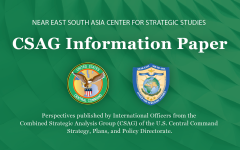Ceasefire Part 1 – Understanding Threat Perception
August 28, 2024 2025-03-16 14:03Ceasefire Part 1 – Understanding Threat Perception
Ceasefire Part 1 – Understanding Threat Perception
CSAG STRATEGY PAPER
Sanna Stark (CF4), SWE Armed Forces (CSAG/CCJ5)
20 August 2024
Introduction:
Despite many months of pressure from the international community regarding a ceasefire in Gaza, the level of hostilities and distrust remains high. It is therefore pertinent to keep in mind both the strategic objectives of sustainable governance solutions for the Palestinian territories, and the urgent initial steps needed to relieve the civilian population from harm. A ceasefire is one of the most important elements for a credible starting point for future agreements on conflict resolution. Without a ceasefire, humanitarian aid cannot flow sufficiently into Gaza and the possibility for negotiating a sustainable peace settlement and rebuilding infrastructure are miniscule. The current situation also contributes to an unsustainable security situation for both the Palestinian as well as the Israeli people. This CSAG Strategy Paper is the first in a series of papers that will shed light on what pre-conditions affects the possibility for a ceasefire, such as threat perception, conflict ripeness, timing, and mediation / negotiation strategy.
Since October 7 last year when Hamas carried out the heinous surprise attack against Israel killing over 1200 Israeli citizens and foreign nationals, and taking over 250 hostages, it has been evident that balanced measures for conflict resolution are lacking. The response by the State of Israel that followed the attacks together with the ongoing war, continuous threat against Israel, and extreme suffering of the Palestinian civilians in Gaza, underlines this absolutely. Due to the sense of urgency that the humanitarian situation, security situation, and the risk for regional spillover / escalation create, the importance of the international community’s active engagement in breaking the cycle of violence cannot be over-stated.
The main objective of the paper is to identify some of the root causes for the lack of progress in the negotiations concerning a ceasefire through the lens of threat perception. The paper addresses the belligerents’ (Hamas and Israel) different threat perceptions from the perspective of both material and ideational force, and how these elements reinforce one another. A fundamental understanding of the belligerents’ threat perceptions can possibly enable more targeted and efficient negotiations as well as address the international community’s role in mediation efforts. The main question being posed is therefore:
– What are the belligerents’ main threat perceptions and how are these affecting the prospects for a ceasefire?
Key Points:
- The paper’s main objective is to identify some of the root causes for the lack of progress in the negotiations concerning a ceasefire in the ongoing war between Hamas and Israel.
- Analyzing the belligerents’ threat perceptions creates a space to explore a solution by understanding the current conditions and historical background of the conflict. Without having a deep understanding as to why the different actors behave in a certain way, the how to move towards a ceasefire and ultimately a long-term solution may remain obscured.
- The competition between identity narratives contributes to a zero-sum game where each side perceives the other’s gain as its own loss – a dynamic which makes compromise extremely challenging and would undermine core aspirations.
- Given the importance that both belligerents place on the territorial rights to the holy land and its religious meaning, there is a powerful reinforcement between threat perceptions from ideational and material force.
- Hamas’ autonomy in making operational decisions concerning a ceasefire together with Israel’s willingness to de-escalate may be decisive factors for the prospects of a ceasefire, which is why conflict ripeness and exit strategies will be addressed in the next part of the series.
- The current situation might be the new normal since threat perception give little room for compromise.
View other USCENTCOM Combined Strategic Analysis Group (CSAG) papers here.
The opinions and conclusions expressed herein are those of a number of international officers within the Combined Strategic Analysis Group (CSAG) and do not necessarily reflect the views of United States Central Command, not of the nations represented within the CSAG or any other governmental agency.



